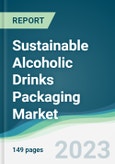The global sustainable alcoholic drinks packaging market is estimated to grow at a CAGR of 5.54% during the forecast period.
The market is associated with the production and utilization of packaging materials for alcoholic beverages that are environment-friendly and minimize negative impacts on the planet. Sustainable packaging aims to reduce carbon emissions and pollution while preserving natural resources. It encourages the use of materials like glass, aluminum, or paper that can be recycled or reused, rather than single-use plastics that contribute to pollution and landfill waste. By adopting sustainable packaging practices, the alcoholic drinks industry strives to make a positive contribution towards a greener and more sustainable future.Market-Drives:
Growing consumer awareness regarding sustainable packaging.
The sustainable alcoholic drinks packaging market is driven by increasing consumer awareness and demand for environmentally friendly packaging options. Stringent government regulations and policies aimed at reducing plastic waste further encourage the adoption of sustainable packaging practices. Innovations in packaging technologies and materials, such as biodegradable and compostable options, are also contributing to the growth of this market. As a result, alcoholic beverage manufacturers are increasingly adopting sustainable packaging solutions to meet consumer expectations and comply with regulations, fuelling the expansion of the sustainable alcoholic drinks packaging market.Consumer Preferences and Lifestyle Choices.
Consumer preferences and lifestyle choices play a crucial role in the growth of the sustainable alcoholic drinks packaging market. With heightened environmental awareness, consumers are actively seeking alcoholic beverages packaged in eco-friendly materials. Products that demonstrate a commitment to sustainability and meet consumer expectations are gaining a competitive edge. As a result, alcoholic beverage manufacturers are embracing sustainable packaging solutions to meet the demand and stay relevant in the market.Increased Disposable income will aid the market growth in the projected period:
Higher disposable income can lead to increased consumer demand for sustainable packaging options as they prioritize products that align with their values and preferences. This increased purchasing power allows consumers to choose higher-priced products that focus on sustainability, contributing to the growth of the sustainable alcoholic drinks packaging market.Stringent regulations and policies.
Governments worldwide are implementing regulations and policies aimed at reducing plastic waste and promoting sustainable practices. These regulations compel alcoholic beverage manufacturers to adopt sustainable packaging solutions to meet legal requirements and avoid penalties. They promote the use of renewable, recyclable, and biodegradable materials while reducing waste and energy consumption. Additionally, such regulations help in encouraging innovation and investment in sustainable packaging technologies. Overall, government regulations drive the industry towards environmentally friendly practices, shaping the growth of the sustainable alcoholic drinks packaging market.Technological Advancements.
Technological advancements drive innovation, making eco-friendly packaging options more efficient and cost-effective. Improved materials and manufacturing processes enable the production of sustainable packaging materials. Logistics and transportation technologies enhance supply chain efficiency, reducing environmental impact. Additionally, advancements enable better tracking and recycling of packaging materials, minimizing waste. Innovations in packaging technologies and materials have made sustainable options more viable and cost-effective.Brand reputation and consumer loyalty.
Brands that establish a positive reputation for their commitment to sustainability and responsible packaging practices are more likely to attract eco-conscious consumers. When consumers perceive a brand as environmentally responsible, they develop a sense of trust and loyalty toward that product. As a result, they are more inclined to choose alcoholic beverages that are packaged sustainably. This preference for sustainable packaging options contributes to the growth of the sustainable alcoholic drinks packaging market. Firms that prioritize sustainability gain consumer loyalty and create a positive brand image, setting themselves apart from competitors and driving the adoption of sustainable practices throughout the industry.Retailer and industry initiatives.
Retailers and industry associations play a vital role in promoting and encouraging sustainable packaging practices. They can set sustainability standards, collaborate with suppliers to implement eco-friendly packaging solutions, and educate consumers about the importance of choosing sustainable options. These initiatives create awareness and drive demand for alcoholic beverages packaged in environmentally friendly materials. By actively supporting and promoting sustainable packaging, retailers and industry associations contribute to the growth of the sustainable alcoholic drinks packaging market, encouraging more businesses to adopt sustainable practices and meet consumer expectations for eco-conscious choices.Asia Pacific region is expected to dominate the market:
The Asia Pacific region is set to dominate the sustainable alcoholic drinks packaging market owing to its large population, rising incomes, and increasing environmental awareness. Stringent government regulations, rapid urbanization, and a shift towards sustainable consumption patterns further contribute to its dominance. The region offers significant market opportunities driven by the demand for eco-friendly packaging materials and premium sustainable alcoholic beverages.Recent Developments:
- In June 2023:Absolut Vodkaintroduced a fresh bottle composed of 57% paper, featuring a plastic coating, affirming their commitment to creating a bottle that is entirely derived from bio-based materials.
Segmentation:
By Packaging Type
- Bottles
- Metal Cans
- Carton
- Jars
- Others
By Material
- Glass
- Metal
- Others
By End-User
- Beer Industry
- Wine Industry
- Spirit Industry
- Others
By Geography
- North America
- United States
- Canada
- Mexico
- South America
- Brazil
- Argentina
- Others
- Europe
- United Kingdom
- Germany
- France
- Italy
- Spain
- Others
- Middle East and Africa
- Saudi Arabia
- UAE
- Others
- Asia Pacific
- Japan
- China
- India
- South Korea
- Taiwan
- Thailand
- Indonesia
- Others
Table of Contents
Companies Mentioned
- Crown
- Smurfit Kappa
- Vidrala S.A
- Amcor Plc
- Mondi
- SIG
- ActionPak Inc.
- Graham Packaging Company Inc.
- Iconic Brands Inc.
Methodology

LOADING...








